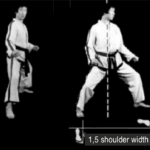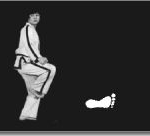Historical background
“WON-HYO” was the name of the monk who introduced Buddhism to the Silla Dynasty in the year 686 AD.
Knowledge for the 5th Kup
Taekwondo students learn the techniques of Matsogi. Those are taught with the movements from the tuls to learn how to apply them in sparring.
There are three types of Matsogi: Sambo Matsogi (three step sparring), Ibo Matsogi (two-step sparring) and Il- bo Matsogi (one step sparring).
For this exam, candidates must perform 12 Sambo Matsogi and 5 IBO Matsogi. This is done in pairs.
IBO Matsogi Methodology
The difference with the Sambo Matsogi consists in the method of attack: in contrast to the three step sparring, where the attacker attacked three times with the same attack, the attack is two-step sparring consists off two different attacks; one kick and one punch, or vice versa. The defender tells the attacker which ones to execute.
Similarly, the starting position, in which the attacker starts, is different from the SAMBO MATSOGI.
Instead of a GUNNUN SOGI NAJUNDE BAKKAT PALMOK MAKGI, the attacker begins in NIUNJA SOGI PALMOK DAEBI MAKGI.
BREAK TECHNIQUES OR KYEK PA
Many think that they need a big shape and size needed to break a board. But that is not so. There are different things to look at. Here are the factors which lead to a higher degree of physical strength.
-
- Action-Reaction : Every force has an equal and opposite force. Therefore, in taekwondo with every move you make, the hand is quickly withdrawn to the hip.
- Concentration: The maximum power is only given at the time of impact.
- Balance: The body is balanced with each technique. This can be done by taking a proper position to take.
- Breathing: The control of breathing not only affects the speed and power. It can also prepare the body for a fight. Never breathe at the moment of the impact!
- Wave motion: Relationship strength – relaxation.
- Speed: Speed is the most essential factor when invoking force or pressure.
Scientifically, force equals mass times acceleration : Force = mass x speed
To know : The bursting test must be passed with 1.5 to 3.5 cm wide pine 30×30 cm plank of wood.
How to proceed?
-
-
- Come to the place, then greet.
- Measure the distance down to the shelf. Take a good distance, certainly not too short.
- Breathe in and out. Measure one more time the distance.
- Come in JUNBI.
- Break the shelf.
- Come back in JUNBI.
- Greet.
-
Note: Always be peaceful and calm. Remember, use your whole body. You break the board with your hips and shoulders. Get it off your power. Also remember; you won’t try to break it; you will break it.
Hand technique for 6th Kup
| Korean | English |
| NOPUNDE SONKAL ANURO TAERIGI | High knife-hand inward strike |
| AN PALMOK DOLLIMYO MAKGI | Forearm circular block |
Foot technique for 6th Kup
| Korean | English |
| YOP CHAGI | Side piercing kick |
| YOPCHA JIRUGI | Side piercing kick and punch together |
Positions for 6th Kup



